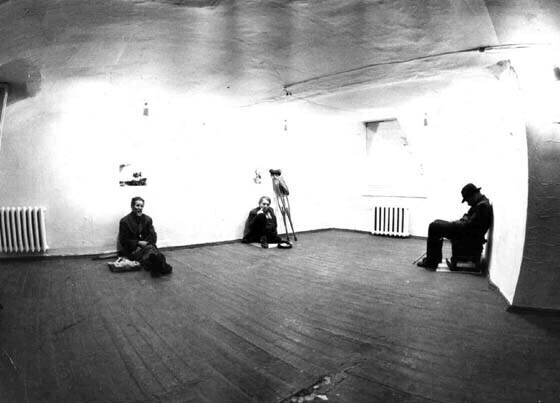Participants: The evening will be attended by curators and exhibitors Tryokhprudny Lane Gallery Vladimir Dubosarskiy, Ilya Kitup, Alexander Sigutin, Yuri Shabelnikov
Tryokhprudny Lane Gallery, which opened in September 1991 at 3/1 Tryokhprudny Lane, Moscow, functioned as a cross between a commercial gallery space and a non-profit contemporary art institution.
The artist-run space concept adopted by Tryokhprudny Lane Gallery was a novelty in post-Soviet Russia. Importantly, the idea was born outside the circle of professional art historians and managers; the perennially open gallery was initiated by a group of artists who inhabited a half-abandoned building in downtown Moscow.
The group was built around artists from the Rostov-based Art or Death community. The house in Tryokhprudny Lane became an artistic colony in 1991, when Avdey Ter-Oganyan, Konstantin Reunov, and Valery Koshlyakov moved into its vacant apartments, joined later by fellow artists Vladimir Dubossarsky, Pavel Aksyonov, Ilya Kitup, Alexander Sigutin, and others. Despite the widespread practice of squatting at the time, the workshop residents actually rented the space from the building’s owner.
In August 1991 the tenants decided to turn the house’s attic into an exhibition space. New exhibitions would open each Thursday, accompanied by special booklets; the openings were attended by selected friends, artists, and critics. The gallery was run by collective management and pursued no commercial purposes.
The 36-square-meter space, redesigned by the artists, opened on September 5, 1991, with the exhibition-cum-performance Mercy. In the two seasons before its demise, the gallery had hosted 87 shows, with eight more organized by the community outside the space.
The Thursday exhibitions at Tryokhprudny Lane Gallery defied conventional models. They incorporated performance acts and interactive installations, custom-made for the gallery space. Overall, Tryokhprudny art can be characterized as vigorous, cheeky, and ironic.
In May 1993 Tryokhprudny Lane Gallery was forced to close for the building’s reconstruction. During its short lifespan, the gallery had become a key venue and had elevated the status of new artists within Moscow’s professional artistic milieu.
Entrance to all education events is free. Before attending, please check the schedule at garagemca.org.




